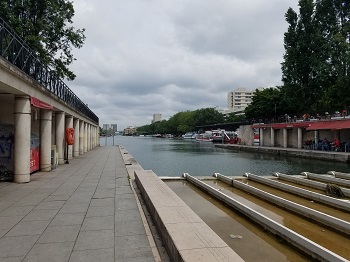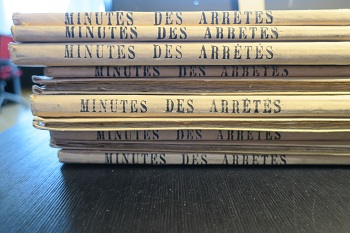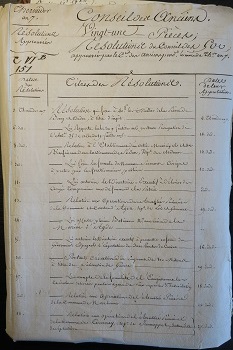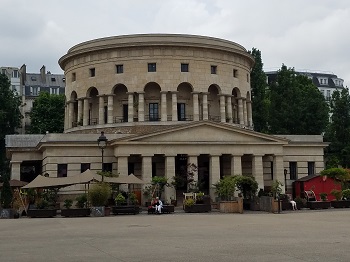Paris in June by Richard Siegler
INFR Research Blog Post #1
6-5-17, Paris

As I sit at the Bassin de la Villette waiting for the archives to reopen after Pentecost weekend, now would seem the perfect time to write my first blog post about life in Paris and my research experience. But before discussing my current work, I want to briefly outline my previous research experience and dissertation project. I was fortunate enough to spend a month last summer doing preliminary research in six different Parisian archives in preparation for the bulk of my dissertation research thanks to funding from the Institute on Napoleon and the French Revolution and the Masséna Society. This preliminary trip afforded me the opportunity to gain a familiarity with the main archives for my project, which examines social instability during the French Revolution and the new regime’s struggle to fulfill its duties to society by following the abolition and return of octrois. These were local taxes collected by cities and towns on foodstuffs, beverages, fodder, fuels, and building materials that paid for a range of public services from firefighting, policing, street-lighting and sludge removal to welfare, hospices, prisons, provisioning, and road repair.

Having arrived on May 24, I completed a productive week at the Archives Nationales Pierrefitte-sur-Seine sifting through and photographing documents from 48 boxes. Much of this work centered on the AF/III series and the C series (Assemblées Nationales) in order to map out how the Directory, Ministry of the Interior, Conseil des Cinq-Cents, and Conseil des Anciens decided upon reestablishing octrois rather than other proposed taxes and the process by which cities were granted an octroi. AF (archives du pouvoir exécutif)/III contains the hand-written minutes of the procès-verbaux of each session of the two legislative chambers, the minutes for the orders, messages, letters, and reports of the Executive Directory, ministerial correspondence with the Directors, and all sorts of local and departmental requests from across France. Particularly important for my project are the requests communes sent to the legislative chambers seeking authorization to establish an octroi by highlighting their annual deficit and proposing a tarif (the list of items to be taxed and at what rate). Other materials relate to the long process of reestablishing the octroi de Paris, including the nomination of the receviers, controllers, commis, and other agents who would collect the tax revenue, as well as the dismissal of officers for aiding and abetting smuggling or taking bribes.

The AF series dovetails nicely with serie C, which contains the papers of the revolutionary assemblies, the procès-verbaux for the sessions of the different legislative bodies, and all sorts of petitions, pamphlets, requests, and dossiers sent by local officials and private citizens to the legislature. While the AF series contains the official requests from cities to establish an octroi, usually a two or three page document, local administrators also sent the Conseil des Cinq-Cents and Conseil des Anciens large dossiers with all sorts of financial records from throughout the 1790s. These materials serve as the basis of the printed reports presented by the commission on finances to the legislature (found in the AD series) in support of a particular commune being granted an octroi. On the whole, the dozens of dossiers that I have found thus far offer concrete and extensive evidence of communes struggling meet their ordinary expenses, burdened with enormous annual deficits and heavily reliant on the national treasury and Ministry of the Interior for aid.
Taken together, these two series provide a strong administrative and financial perspective on local instability during the Revolution and the inability of communes to fund the public duties that were being delegated to them by the national governmnet. In the coming weeks I hope to investigate how people experienced this instability, what they said about it, and what they thought of the solution—the restoration of Old Regime octrois in a new guise—by delving into petitions and pamphlets sent to the revolutionary assembles, the F1c III series (Esprit Public), BB18 (Correspondance Générale de la Division Criminelle), F7 (Police Générale), and F/15 (Hospices et secours).

But, of course, this trip has not only been about business as the holiday closures of the AN have given me the opportunity to explore parts of the 19e, 10e, and 11e arrondissements close to my neighborhood. In particular, I have enjoyed walking along the canal Saint Martin and sitting by the bassin de la Villette where one of the few remaining octroi barriers still stands from the original wall of the Farmer’s General. I have also had the pleasure of discussing history and archives, watching football, and enjoying good food with Harrison Diskin, an alumni of FSU now working with Jacob Soll at USC.
In closing, I would like to give a special thank you to the Fondation Napoléon and Masséna Society whose generous funding has made this research trip possible.
- Richard
